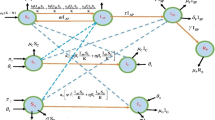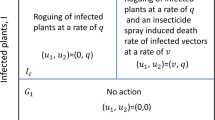Abstract
Farmers are trying to adopt new cultivation methods and technologies to produce more and good yield. Low productivity is due to a variety of factors; one of the main reasons is the existence of plant diseases spread by insects and pathogens. Infection in the plants of red chilli via the yellow virus is a current issue for the farmers. Here, we construct a model for the propagation of the yellow virus in the plants of red chilli to investigate the key factors. The proposed model is then presented in the framework of fractional derivative for more accurate findings. By applying the method of next-generation matrix, we determine the basic reproduction number \({\mathcal {R}}_0\). The recommended model is investigated for biological meaningful results. Moreover, we focus on the dynamical behavior and qualitative analysis of the yellow virus infection in the plants of red chili. Schaefer and Banach fixed-point theorems are utilized to demonstrate the uniqueness and existence of the solution of the recommended system. We find suitable circumstances for the Ulam–Hyers stability of the recommended system of plants infection. The solution routes are examined using a unique numerical method to highlight the contribution of the input factors on yellow virus dynamics. Key factors of the system are investigated numerically through different simulations. The most critical factors of the infection are highlighted to the policymakers for the prevention of the losses.






Similar content being viewed by others
Data availability
No new data and materials are related to this research work.
References
R.M. Mateos, A. Jimenez, P. Román, F. Romojaro, S. Bacarizo, M. Leterrier, M. Gómez, F. Sevilla, L.A. Del Río, F.J. Corpas, J.M. Palma, Antioxidant systems from pepper (Capsicum annuum L.): involvement in the response to temperature changes in ripe fruits. Int. J. Mol. Sci. 14(5), 9556–9580 (2013)
S.N. Fathima, A systemic review on phytochemistry and pharmacological activities of Capsicum annuum. Int. J. Pharm. Pharm. Sci. 4(3), 51–68 (2015)
S.B. Anoraga, I. Sabarisman, M. Ainuri, Effect of different pretreatments on dried chilli (Capsicum annum L.) quality. In IOP Conference Series: Earth and Environmental Science (Vol. 131, No. 1, p. 012014). IOP Publishing (2018)
R. Amelia, N. Anggriani, N. Istifadah, A.K. Supriatna, Dynamic analysis of mathematical model of the spread of yellow virus in red chili plants through insect vectors with logistical functions. In AIP Conference Proceedings (Vol. 2264, No. 1, p. 040006). AIP Publishing LLC (2020)
R. Sharma, V.K. Joshi, Development and evaluation of bell pepper (Capsicum annuum L.) based instant chutney powder. Indian J. Nat. Prod. Resour. 5(3), 262–267 (2015)
F.A. Khan, T. Mahmood, M. Ali, A. Saeed, A. Maalik, Pharmacological importance of an ethnobotanical plant: Capsicum annuum L. Nat. Prod. Res. 28(16), 1267–1274 (2014)
Y. Hidayat, M.R. Fauziaty, D. Dono, The effectiveness of vegetable oil formulations in reducing oviposition of Bactrocera dorsalis Hendel (Diptera: Tephritidae) in large red chili fruits. Indonesian J. Entomol 15, 93–100 (2018)
Y. Hidayat, R.F. Ferera, A.F. Ramadhan, W. Kurniawan, E. Yulia, S. Rasiska, Combination of edible vegetable oil and artificial fruit to reduce Bactrocera dorsalis oviposition in chilli fruits. J. Appl. Entomol. 143(1–2), 69–76 (2019)
M.J. Jeger, F. Van den Bosch, L.V. Madden, Modelling virus-and host-limitation in vectored plant disease epidemics. Virus Res. 159(2), 215–222 (2011)
P. Kumar, D. Baleanu, V.S. Erturk, M. Inc, V. Govindaraj, A delayed plant disease model with Caputo fractional derivatives. Adv. Contin. Discret. Model. 2022(1), 1–22 (2022)
A.M.A. El-Sayed, S.Z. Rida, Y.A. Gaber, Dynamical of curative and preventive treatments in a two-stage plant disease model of fractional order. Chaos Solit. Fractals 137, 109879 (2020)
A. Murwayi, T. Onyango, B. Owour, Mathematical analysis of plant disease dispersion model that incorporates wind strength and insect vector at equilibrium. Br. J. Math. Comput. Sci. 22(1), 1–17 (2017)
A.L.M. Murwayi, T. Onyango, B. Owour, Estimated numerical results and simulation of the plant disease model incorporating wind strength and insect vector at equilibrium. J. Adv. Math. Comput. Sci. 25(2), 1–17 (2017)
T. Nakazawa, T. Yamanaka, S. Urano, Model analysis for plant disease dynamics co-mediated by herbivory and herbivore-borne phytopathogens. Biol. Lett. 8(4), 685–688 (2012)
S.Z. Rida, M. Khalil, H.A. Hosham, S. Gadellah, Mathematical model of vector-borne plant disease with memory on the host and the vector. Progress Fract. Differ. Appl. 2(4), 227–285 (2016)
L.V. Madden, G. Hughes, F. Van Den Bosch, The study of plant disease epidemics (No. 63.23 M33) (American Phytopathological Society, St. Paul, 2007)
X.S. Zhang, J. Holt, J. Colvin, Mathematical models of host plant infection by helper-dependent virus complexes: why are helper viruses always avirulent? Phytopathology 90(1), 85–93 (2000)
M.J. Jeger, Z. Chen, G. Powell, S. Hodge, F. Van den Bosch, Interactions in a host plant-virus-vector-parasitoid system: modelling the consequences for virus transmission and disease dynamics. Virus Res. 159(2), 183–193 (2011)
N.J. Cunniffe, C.A. Gilligan, A theoretical framework for biological control of soil-borne plant pathogens: identifying effective strategies. J. Theor. Biol. 278(1), 32–43 (2011)
M.D. Castle, C.A. Gilligan, An epidemiological framework for modelling fungicide dynamics and control. PLoS One (2012). https://doi.org/10.1371/journal.pone.0040941
M. Vellappandi, P. Kumar, V. Govindaraj, W. Albalawi, An optimal control problem for mosaic disease via Caputo fractional derivative. Alex. Eng. J. 61(10), 8027–8037 (2022)
N. Anggriani, N. Istifadah, M. Hanifah, A.K. Supriatna, A Mathematical Model of Protectant and Curative Fungicide Application and its stability analysis. In IOP Conference Series: Earth and Environmental Science (Vol. 31, No. 1, p. 012014). IOP Publishing (2016)
N. Anggriani, M.Z. Ndii, D. Arumi, N. Istifadah, A.K. Supriatna, Mathematical model for plant disease dynamics with curative and preventive treatments. In AIP Conference Proceedings (Vol. 2043, No. 1, p. 020016). AIP Publishing LLC (2018)
N. Anggriani, M.Z. Ndii, N. Istifadah, A.K. Supriatna, Disease dynamics with curative and preventive treatments in a two-stage plant disease model. In AIP Conference Proceedings (Vol. 2043, No. 1, p. 020010). AIP Publishing LLC (2018)
R. Amelia, N. Anggriani, A.K. Supriatna, Optimal control model of Verticillium lecanii application in the spread of yellow red chili virus. WSEAS Trans. Math. 18, 351–358 (2019)
L.V. Nedorezov, Paramecium aurelia dynamics: non-traditional approach to estimation of model parameters (on an example of Verhulst and Gompertz models). Ecol. Model. 317, 1–5 (2015)
M.I. Abbas, M. Alessandra Ragusa, Solvability of Langevin equations with two Hadamard fractional derivatives via Mittag-Leffler functions. Appl. Anal. 101(9), 3231–3245 (2022)
M.I. Abbas, M.A. Ragusa, Nonlinear fractional differential inclusions with non-singular Mittag-Leffler kernel. AIMS Math 7(11), 20328–20340 (2022)
S. Etemad, M.M. Matar, M.A. Ragusa, S. Rezapour, Tripled fixed points and existence study to a tripled impulsive fractional differential system via measures of noncompactness. Mathematics 10(1), 25 (2022)
A.A. Kilbas, H.M. Srivastava, J.J. Trujillo, Theory and applications of fractional differential equations (Elsevier, North-Holland, 2006). (Mathematics studies)
I. Podlubny, Fractional differential equations: an introduction to fractional derivatives, fractional differential equations, to methods of their solution and some of their applications (Elsevier, 1998)
A. Granas, J. Dugundji, Elementary fixed point theorems, in Fixed point theory. (Springer, New York, 2003), pp.9–84
V.F. Morales-Delgado, J.F. Gomez-Aguilar, M.A. Taneco-Hernandez, Analytical solutions of electrical circuits described by fractional conformable derivatives in Liouville-Caputo sense. AEU-Int. J. Electron. Commun. 85, 108–117 (2018)
H.M. Srivastava, R. Jan, A. Jan, W. Deebani, M. Shutaywi, Fractional-calculus analysis of the transmission dynamics of the dengue infection. Chaos Interdiscip. J. Nonlinear Sci. 31(5), 053130 (2021)
K. Dietz, The estimation of the basic reproduction number for infectious diseases. Stat. Methods Med. Res. 2(1), 23–41 (1993)
O. Diekmann, J.A.P. Heesterbeek, M.G. Roberts, The construction of next-generation matrices for compartmental epidemic models. J. R. Soc. Interface 7(47), 873–885 (2010)
R. Hilfer (ed.), Applications of fractional calculus in physics (World scientific, 2000)
A.A. Kilbas, H.M. Srivastava, J.J. Trujillo, Theory and applications of fractional differential equations, vol. 204 (Elsevier, 2006)
V. Lakshmikantham, S. Leela, J.V. Devi, Theory of fractional dynamic systems (CSP, 2009)
M.S. Abdo, S.K. Panchal, K. Shah, T. Abdeljawad, Existence theory and numerical analysis of three species prey-predator model under Mittag-Leffler power law. Adv. Difference Equ. 2020(1), 1–16 (2020)
T.Q. Tang, Z. Shah, E. Bonyah, R. Jan, M. Shutaywi, N. Alreshidi, Modeling and analysis of breast cancer with adverse reactions of chemotherapy treatment through fractional derivative. Comput. Math. Methods Med. (2022). https://doi.org/10.1155/2022/5636844
S.M. Ullam, Problems in modern mathematics (Chapter VI) (Wiley, New York, 1940)
D.H. Hyers, On the stability of the linear functional equation. Proc. Natl. Acad. Sci. U.S.A. 27(4), 222 (1941)
T.M. Rassias, On the stability of the linear mapping in Banach spaces. Proc. Am. Math. Soc. 72(2), 297–300 (1978)
Z. Ali, A. Zada, K. Shah, On Ulams stability for a coupled systems of nonlinear implicit fractional differential equations. Bull. Malays. Math. Sci. Soc. 42(5), 2681–2699 (2019)
A. Benkerrouche, M.S. Souid, S. Etemad, A. Hakem, P. Agarwal, S. Rezapour, S.K. Ntouyas, J. Tariboon, Qualitative study on solutions of a Hadamard variable order boundary problem via the Ulam-Hyers-Rassias stability. Fractal Fract. 5(3), 108 (2021)
Funding
No funding is associated with the current research work.
Author information
Authors and Affiliations
Contributions
AJ and FAA conceptualized, investigated, analyzed, and validated the research; while, SB and RJ formulated, investigated, numerically examined, reviewed, and supervised this research work.
Corresponding author
Ethics declarations
Conflict of interest
There is no competing interests regarding this research work.
Ethical approval
There is no ethical issue in this work. All the authors actively participated in this research and approved it for publication.
Rights and permissions
Springer Nature or its licensor (e.g. a society or other partner) holds exclusive rights to this article under a publishing agreement with the author(s) or other rightsholder(s); author self-archiving of the accepted manuscript version of this article is solely governed by the terms of such publishing agreement and applicable law.
About this article
Cite this article
Jan, A., Boulaaras, S., Abdullah, F.A. et al. Dynamical analysis, infections in plants, and preventive policies utilizing the theory of fractional calculus. Eur. Phys. J. Spec. Top. 232, 2497–2512 (2023). https://doi.org/10.1140/epjs/s11734-023-00926-1
Received:
Accepted:
Published:
Issue Date:
DOI: https://doi.org/10.1140/epjs/s11734-023-00926-1




